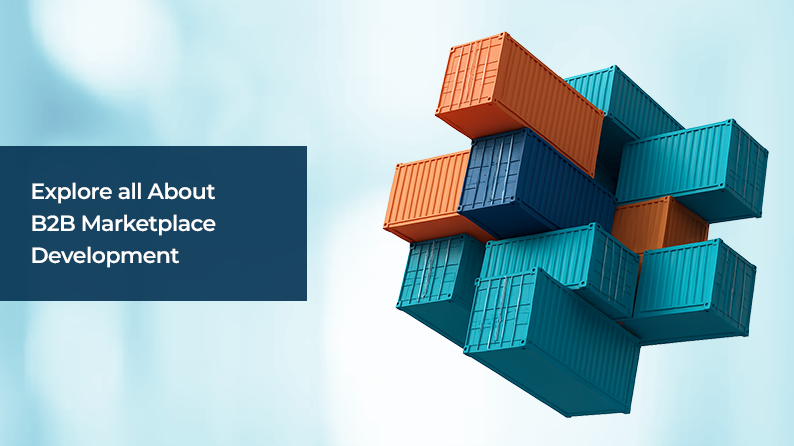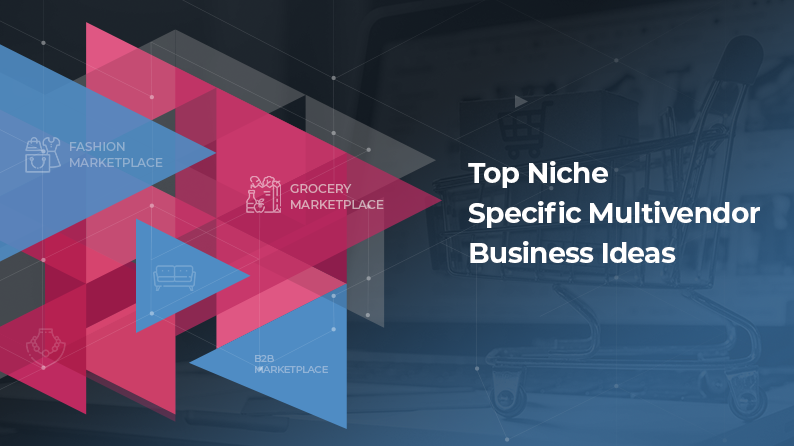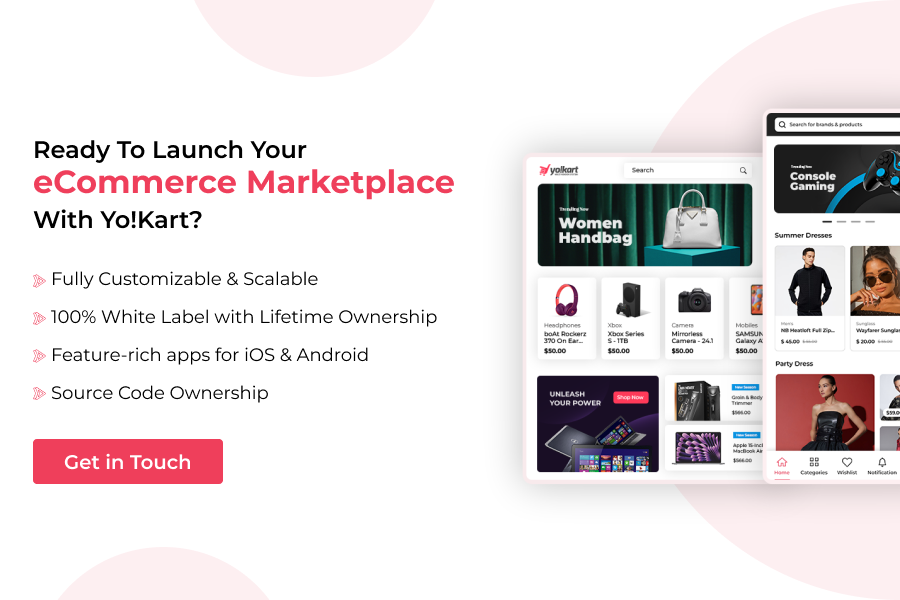Published Date 07th October 2025
The B2B eCommerce industry is on the rise. A decade ago, going digital was just an option. However, today it’s a condition if you want your business to thrive. Why so? Let’s take a look at the statistics to gain a better understanding.
According to the International Trade Administration, the global B2B eCommerce market is expected to reach $36 trillion by 2026.
The report indicates that a significant percentage of B2B trade is occurring online. Businesses are increasingly preferring speed, transparency, convenience, variety and user-friendly digital experiences on marketplaces compared to traditional business transactions, where options were limited and less transparent.
However, for entrepreneurs and startups, it’s high time to invest in developing B2B marketplaces. The highlight and key motivation today is that developing an eCommerce platform doesn’t require a million-dollar investment. You can build a multi-vendor B2B marketplace with low startup costs if you are smart enough to make the right decisions.
This informative blog is all about developing B2B multi-vendor marketplaces. From the B2B marketplace definition to a cost-effective solution to build a marketplace with the right approach, you will discover everything you need to know.
Table of Contents
- What is a B2B Marketplace?
- Top 5 B2B Multi-Vendor Marketplaces Worldwide
- What are the Different Types of B2B Marketplaces?
- Top 10 Must-Have Features of a B2B Marketplace
- Revenue Model: How Does a B2B Marketplace Make Money?
- How to Develop a B2B Multi-Vendor Marketplace Easily?
- Key Challenges When Developing a B2B Marketplace from Scratch
- Solutions to the Key Challenges Mentioned Above
- How Much Does It Cost to Develop/Build a B2B Marketplace?
- Build a Thriving B2B Multi-Vendor Marketplace with Yo!Kart
- Advantages of Developing Your B2B Marketplace with Yo!Kart B2B
- B2B Marketplaces Launched with Yo!Kart and Team
- Final Thought
- FAQs
What is a B2B Marketplace?
A B2B (Business-to-Business) marketplace is a platform that enables trade between two business entities. It connects manufacturers, distributors, wholesalers, and retailers as buyers and sellers, allowing them to buy and sell products or book specialized services online. Unlike a B2C marketplace, a B2B marketplace targets individual businesses that want to buy or sell products in bulk at lower prices. A B2B multi-vendor marketplace provides a diverse range of options and is designed to efficiently handle a high volume of transactions.
Primarily, there are three participants on the B2B marketplace: buyers, sellers and the marketplace operator.
- Buyers: Businesses that search for products, compare prices, request quotes, share customized requirements and buy products from the marketplace in bulk.
- Sellers: Businesses that list and sell their products on the marketplace.
- Admin: The marketplace operator (admin) controls, manages and grows the marketplace by ensuring seamless transactions and operations across the platform.
Top 5 B2B Multi-Vendor Marketplaces Worldwide
Amazon Business, Alibaba, eWorld Trade, DHGate and Global Sources are the top B2B marketplaces. These B2B platforms are leading the industry by connecting millions of buyers and sellers worldwide. They provide a digital infrastructure that streamlines transactions, automates operations, and enables online transactions by enhancing the overall user experience.
| B2B Marketplace | Country of Origin | Launch Year | Active Buyers | Active Sellers | Yearly Revenue | Product Category |
| Amazon Business | United States | 2015 | 8 million | 1.9 million | $107.6 billion in 2024 | Electronics, Home & Kitchen, Fashion, Office Supplies, Health, & Personal Care |
| Alibaba | China | 1999 | 40 million+ | 8+ million | $130.3 billion in 2024 | Machinery, Apparel, Electronics, Home Goods, and Raw Materials |
| eWorldTrade | United States | 2006 | Data not Available | Data not Available | 28 million | Agriculture & Food, Apparel, Industrial Machinery, Electronics, Consumer Goods, & Services |
| DHGate | China | 2004 | 77 million | 2.6 million | Not Available Publicly | Electronics, Clothing, Health & Beauty, & Other Various Goods |
| Global Sources | Hong Kong | 1999 | 10 million | Data not Available | $677.7 million | Electronics, Fashion Accessories, Home & Garden Items & Auto Parts |
Build a B2B Marketplace Like Alibaba, Amazon Business or Global Sources
What are the Different Types of B2B Marketplaces?
B2B marketplaces are categorized into different types based on their offerings, business model and target market. However, they can be primarily categorized into two different types: Horizontal and Vertical. Yet, there are several more types. Let’s explore them:
- Horizontal Marketplaces: Horizontal marketplaces serve diverse industries and niches. They offer a wide variety of products or services. Amazon Business and Alibaba are popular examples of horizontal B2B marketplaces. They offer millions of products across diverse industries.
- Vertical Marketplaces: Vertical marketplaces are focused on a single industry or niche. They target a specialized customer segment and offer products and services particularly to them. Faire is a well-known example of a B2B vertical marketplace. It enables wholesale purchasing of handcrafted items by connecting independent retailers with artisans and makers.
- Product-based Marketplaces: A product-based B2B marketplace focuses on selling physical products. It connects different businesses, enabling them to buy or sell products in bulk. Alibaba and Amazon Business are examples of product-based B2B marketplaces. They connect buyers with suppliers to trade physical products.
- Service-based Marketplaces: A service-based B2B marketplace connects businesses looking for various services with companies or service providers. They facilitate them to leverage skills and professional services instead of physical products. UpWork is an example of a B2B service platform that lets companies hire freelancers for specific projects, and Rakuten Super Logistics and FedEx Fulfillment are famous for providing logistics services for shipping.
- Hybrid Marketplace: A Hybrid marketplace is a combination of both product-based and service-based marketplaces. It offers products and services. It allows third-party vendors and service providers to list physical goods (products) and services both on a single platform. Amazon Business can be considered an example of a hybrid marketplace. Alongside products from diverse categories, it also offers several services as well.
A Comparison table of Different B2B marketplaces types
The comparison table below is a quick overview of different B2B marketplaces that include key characteristics, target audience and popular examples
| Marketplace Type | Key Characteristics | Target Audiences | Popular Examples |
| Vertical | Focused on a single industry, niche, or type of product. | Audience with specialized needs. | Faire and Mable |
| Horizontal | Sells a wide range of goods and services across multiple industries | Customer with varied needs. | Alibaba and Amazon Business |
| Product-Based | Primarily focuses on selling products. | Customer looking for Physical or digital Products | Alibaba and Amazon Business |
| Service-Based | Focuses on scheduling, booking, and project management | Customers looking for specialized skills, professionals or contractors | Upwork, Rakuten Super Logistics and FedEx |
| Hybrid | Sells a variety of tangible and digital products alongside services | Targets a broad customer base | Amazon Business and Alibaba |
From operational aspects, B2B marketplaces can be categorized into several categories. These categories include Supplier-Oriented (e-distribution), Buyer-Oriented (e-procurement), and Intermediary-Oriented (e-exchange) marketplaces.
Top 10 Must-Have Features of a B2B Marketplace
B2B transactions are more complex than B2C or any other business model. Therefore, a B2B multi-vendor marketplace requires some unique features and functionality to simplify complex B2B transactions. The top 10 essential features mentioned below can’t be ignored when you are planning to develop a B2B marketplace.
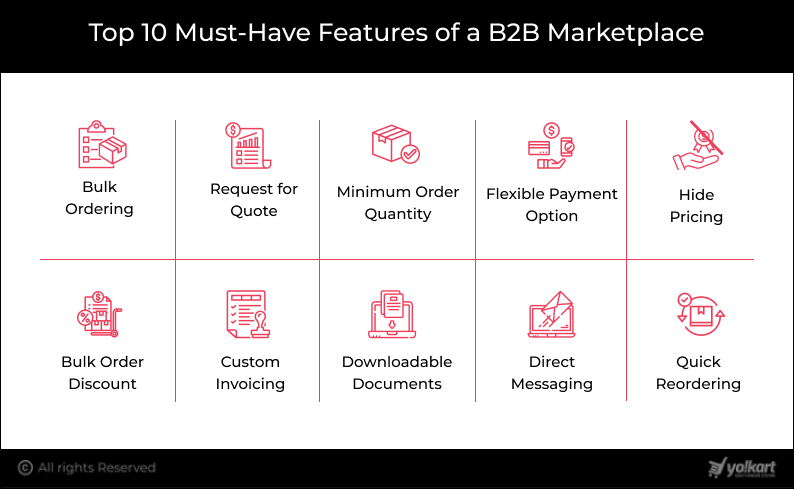
1. Bulk Ordering: B2B orders often require large quantities. The bulk ordering feature enables B2B buyers to place bulk purchases. This feature benefits both buyers and sellers. On the one hand, buyers get more discounts when buying items in large quantities. On the other hand, it leads to higher sales for sellers, allowing them to generate more revenue.
2. Request for Quote (RFQ): Unlike B2C, B2B buyers don’t make purchase decisions immediately with the given buy-now pricing. However, prices can vary significantly depending on order quantity, customization, timeline, and many other factors.
Additionally, making a purchase decision in B2B requires several considerations. The Request for Quote feature also enables buyers to request a quote and sellers to accept, considering all their requirements, and helps them secure the best deal by negotiating the price.
3. Minimum Order Quantity: In B2B, sometimes a fixed associated expense related to production, machinery, or resources that are incurred. The order quantities don’t affect the cost so much, whether the order is placed for 100 or 1000 quantities. The MOQ helps suppliers to manage production costs, streamline operations, and ensure profitability, considering all the associated expenses.
MOQ restricts buyers to place orders at least to the given number. It mandates buyers to make purchases of not less than the quantity defined by the seller. This feature works best for the supplier.
4. Flexible Payment Option: The Flexible payment feature enables payment choices for buyers on the B2B marketplace, allowing them to pay at their convenience, such as in installments or give them a credit term.
B2B trade is conducted in large volumes. Initiating the entire amount at once can affect the financial health of the business. Flexible payment options reduce the friction in the buying process. It helps build a strong customer relationship and provides a competitive advantage.
Sometimes, using flexible payment options, businesses mutually define custom payment terms based on the deliverables, timeline and other aspects to make payment at their convenience.
5. Hide Pricing: Prices on the B2B marketplaces vary significantly depending on several factors. Sometimes, it confuses buyers to finalize the best deal due to its complex or custom pricing structure. In this scenario, the Hide pricing feature is focused on encouraging buyers to proceed with the personalized quotes and discussions in order to grab the best deal based on specific requirements.
6. Bulk Order Discount: A Discount is a kind of incentive or reward that businesses offer to get more sales and generate more revenue. The bulk order discount feature on the B2B marketplace enables sellers to offer discounts to buyers on an increased number of orders.
The discount increases as the orders increase which ultimately offers good profit margins to buyers and drives more sales to sellers.
7. Custom Invoicing: B2B transactions are complex and require customization when invoicing. Unlike B2C transactions, B2B transactions often require custom fields. Therefore, a standard template can’t work for varied business transactions. However, the custom invoicing feature enables businesses, whether sellers or buyers, to share invoices tailored to specific transactions.
8. Downloadable Documents: Several orders on the B2B marketplace required documents. The download document option on the marketplace helps businesses download the documents required. These documents may include certifications, registrations, research papers, test papers, user manuals, guides, agreements or even a simple data sheet containing necessary information.
9. Direct Messaging: Transparent communication and real-time connection are the keys when it comes to handling B2B transactions. Direct messaging enables buyers and sellers on the B2B multi-vendor marketplace. They can interact directly and get a resolution to their queries in real time.
On the one hand, buyers get instant responses to their queries related to the product, its pricing and more to make purchase decisions accordingly. On the other hand, sellers (businesses on the marketplaces) understand and address specific requirements or issues in real time that ultimately increase the chance of converting leads into a loyal customer.
10. Quick Reordering: The Quick Reordering feature enables buyers to place orders faster by making the process straightforward. It eliminates several steps to save time and enhance the overall buying experience. Instead of initiating the process again, the buyer can simply find the order history and reorder in no time.
Explore Out-of-the-box Features of the Best B2B Marketplace Software
Revenue Model: How Does a B2B Marketplace Make Money?
Nailing on the revenue streams is the strategic move. You decide on the strategy for how your marketplace will operate, generate revenue, make profits and sustain in the eCommerce landscape.
Of course, a unique idea that goes beyond what others are following is always great. must always be welcomed. At the same time, one needs to be sure of a revenue model that resonates with your marketplace model and helps you accelerate growth.
Below are a few popular revenue streams that marketplaces commonly follow to make money.
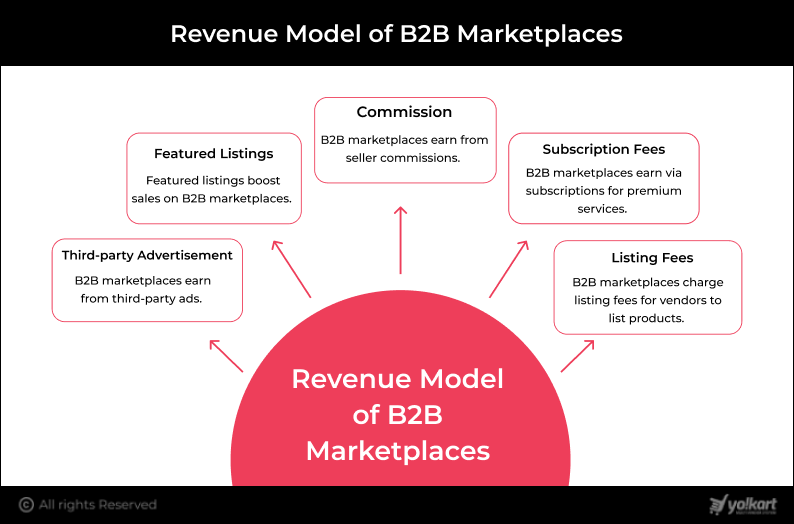
- Commission: A B2B marketplace can charge a commission from the seller/vendor on each sale made via the platform. The commissions can be either a fixed amount or a certain percentage of the selling price. The commission-based revenue model is the most preferred revenue stream. For most marketplaces, a commission-based revenue model is the primary source of revenue generation.
- Subscription Fees: After the commission-based revenue model, the subscription-based revenue model is another prominent revenue source for B2B marketplaces. In this revenue model, the B2B marketplace incurs a monthly, quarterly, or yearly subscription. The marketplace offers premium services to its users for these subscription fees.
| Amazon generated $44 billion in net sales from subscription services in 2024. You can see that a significant percentage of Amazon’s revenue comes from subscriptions. |
- Listing Fees: The B2B marketplaces also charge listing fees. Vendors pay a fee (either a fixed amount or a certain percentage of product price) to list their products on the platform. However, some marketplaces permit free listings and other charge after a certain number of free listings. Listing fee again, about the decision on how much the marketplace is going to charge.
- Featured Listings: A B2B marketplace charges fees from the vendors listed on the platform to promote their store, product categories or individual products on the platform via paid promotions. This type of promotion makes the products appear at the top in search results or often at the top of the page. Featured listing helps vendors to generate more sales by increasing products’ visibility.
- Third-party Advertisement: Third-party advertisement can be another revenue generation stream for the B2B marketplace. In this revenue model, the platform owner allows businesses, not from the platform itself, to run a sponsored ad to promote their product, services, or business on the marketplace by paying charges.
How to Develop a B2B Multi-Vendor Marketplace Easily?
Every business requires the right approach, planning and execution to succeed. Similarly, building a B2B multi-vendor marketplace too. However, many entrepreneurs and business owners don’t know where to start or how to build a thriving B2B multi-vendor marketplace. If you are also planning to build a B2B marketplace, follow these 5 steps given below.
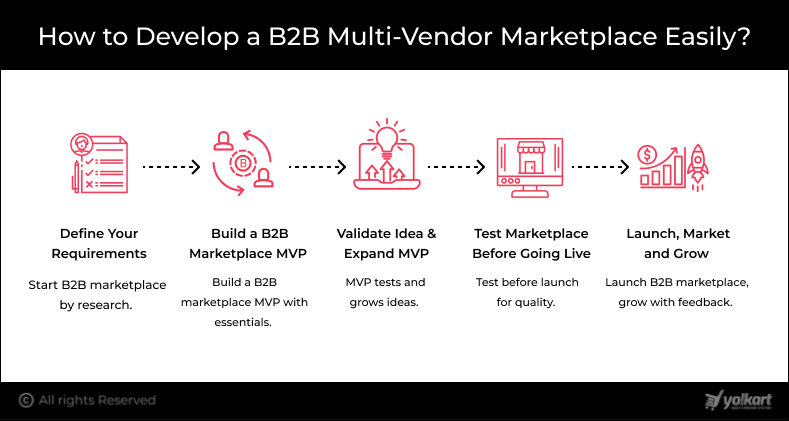
Step 1: Discovery Phase: Define Your B2B Marketplace Requirements
The first step to getting started on your journey to develop a multi-vendor B2B marketplace is to conduct thorough market research.
This process helps in identifying core problems, understanding your target audience, knowing their demographics, finding the right solution, defining the key features, deciding on the business model, and getting an idea of the budget required.
By getting clarity on all the key points and how your marketplace will serve your target market. Now you can define your strategy and streamline the process to avoid unnecessary expenses and time consumption.
Step 2: Development Phase: Build a B2B Marketplace MVP (Minimum Viable Product)
Before you build a full-fledged multi-vendor marketplace, it’s better to develop a marketplace MVP (Minimum Viable Product). It’s kind of an early version of your B2B marketplace with the minimum required features and functionality.
MVP is focused on core functionality rather than comprehensive features. Therefore, it typically takes a fraction of the time and investment, around 10% to 30% of the full-scale B2B multi-vendor marketplace, considering several factors.
Developing a B2B marketplace MVP (Minimum Viable Product) includes:
- Selecting the right tech stack.
- Designing UX/UI for an enhanced user experience.
- Developing necessary features and functionalities such as user profiles, product listings, and a secure transaction process.
- Integrating necessary APIs or third-party tools such as payment gateways, shipping solutions and more.
- Enabling easy checkout and order processing.
Step 3: Idea Validation and Expansion: Validate Idea and Expand MVP Into a Full-Fledged Marketplace
MVP is a great way to validate your idea. It’s introduced to the early adopters to get feedback. It helps you gather valuable data on demand, user experience and marketplace acceptance.
Based on the valuable feedback, suggestions and user demands, the development team implements changes to make the product as seamless as possible. Later, an MVP evolves into a full-fledged marketplace.
Another significant advantage of developing an MVP is that you can scale it as a full-fledged marketplace effortlessly.
| Always be mindful that steady improvement is the key to success. Who doesn’t know about Amazon today? The platform was initially started as an online bookstore. However, later it expanded into an everything store. Moreover, this global eCommerce giant also extends its offerings to cloud infrastructure (AWS – Amazon Web Services) and video streaming, new revenue generation streams. |
Launch a B2B Marketplace MVP at an Affordable Price
Step 4: Quality Assurance: Test Your Full-Fledged Marketplace Before Going Live
Testing a product before it goes live is critical for ensuring quality, reliability, and user satisfaction. This process includes identifying bugs, errors, performance-related challenges and more. At the same time, analyzing whether features are functioning properly or not is also a critical consideration.
In short, testing your marketplace before going live ensures that the solution you introduce is functioning as intended from the very first day. Quality assurance helps you eliminate post-launch customer frustration, avoid costly mistakes, and prevent damage to the brand’s reputation, providing a positive marketplace experience for various user types.
Step 5: Go Live: Launch, Market and Grow Your B2B Multi-vendor Marketplace
Once you have finalized testing your marketplace, the next step is to launch your B2B multi-vendor marketplace, onboard vendors and attract customers.
However, the job is not done yet. Operating an eCommerce platform or any business requires continuous effort. You need to monitor data and iterate based on user feedback.
Additionally, to attract and engage more users, you can plan marketing strategies, run paid campaigns, and follow the latest trends. This is how your marketplace can stand ahead of competitors and help you drive sustainable growth.
Key Challenges When Developing a B2B Marketplace from Scratch
Undoubtedly, building a B2B marketplace from scratch offers more control and helps you tailor the platform based on your personalized needs. However, it also brings several challenges that you can’t ignore when developing a marketplace from scratch.
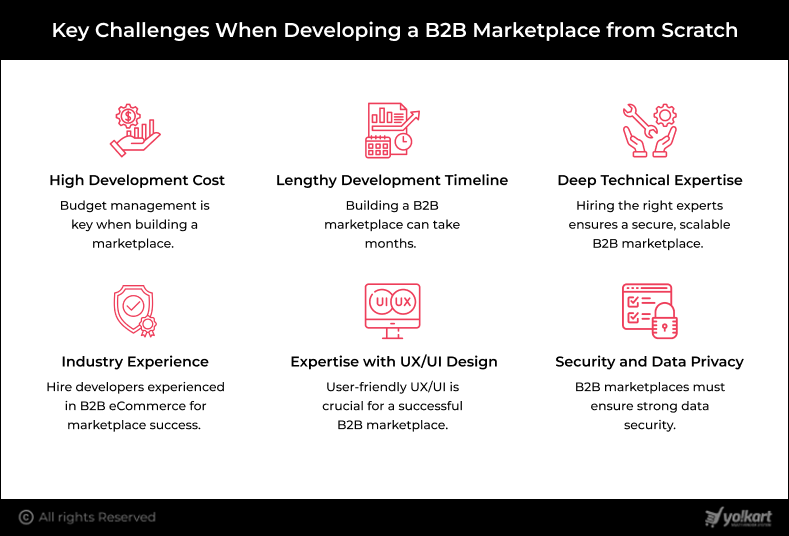
1. High Development Cost
Budget management is the primary challenge when it comes to developing a marketplace from scratch. It requires significant investment in managing experts and resources like skilled developers, designers, project managers, necessary tools and other participants or resources.
2. Custom B2B Marketplace Development Demands More Time
Developing a B2B marketplace from the ground up can take anywhere between 3 to 6 months or more. Sometimes, it may take years. However, factors like the project’s complexity, team size, expertise, availability of resources and more are also among those factors that may cause delays.
3. Need for the Technical Experts
Finding the right technical experts is paramount for custom B2B marketplace development. They can help you develop a secure, scalable, high-quality and high-performing marketplace. In case of a bad hire, you can experience project delay, security vulnerabilities, poor user experience, and lead to project failure.
4. Experience in Developing B2B Marketplace
A developer unfamiliar with the B2B eCommerce industry can’t help you develop a thriving B2B multi-vendor marketplace. Therefore, you need to find experts who have experience in the eCommerce industry, especially those who have built B2B marketplaces. They can surely add value to your project.
5. Intuitive UX/UI Design
Designing a user-friendly and intuitive UX/UI is the primary need for a B2B marketplace. It helps to ensure a seamless experience for different user types. However, most of the businesses fail to find the right UX/UI developers when developing a marketplace from scratch, which ultimately causes poor user experience, higher development costs, damaged brand reputation, lost revenue and more.
6. Security and Data Privacy
For Cyber attacks, marketplaces are the primary targets, especially B2B, where the transactions are initiated in large numbers and more sensitive data is shared. Therefore, developing a secure B2B marketplace and ensuring data security are the primary needs when building a B2B multi-vendor marketplace. Familiarity with security protocols and understanding of privacy controls and network security can help you avoid vulnerabilities.
Yo!Kart B2B is a secure solution that secures data from any breach, attack and threat. It complies with PCI and SSL security standards. From data encryption to ensuring the security of the sensitive data, Yo!Kart can always be the best choice.
Solutions to the Key Challenges Mentioned Above
In the above section of key challenges, you went through several challenges that one may face while developing a B2B multi-vendor marketplace from scratch. Now this section will help you with the right solutions to these challenges.
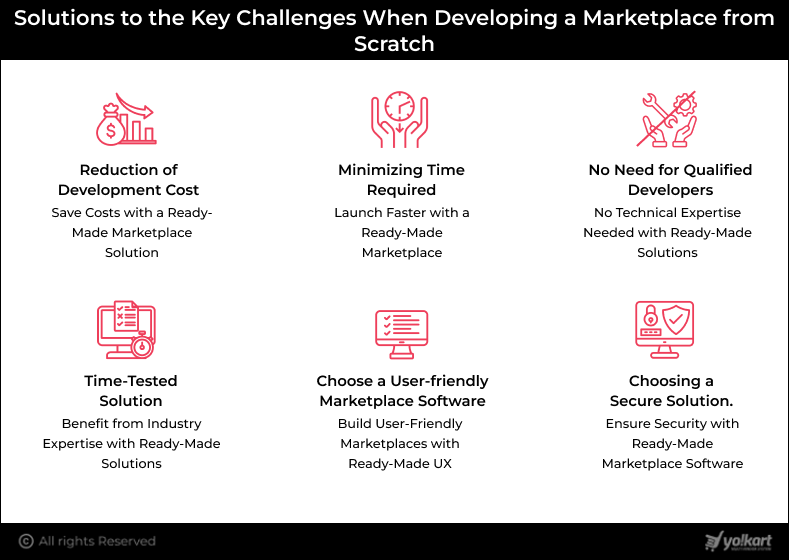
Solution 1 – Reduction of Development Cost
Undoubtedly, developing a marketplace from scratch can cost you more, but what if you can skip the process? Of course, it will save a lot of money.
Now the question may arise: how to skip the process?
However, the most appropriate answer to this question is a readymade solution. Readymade solutions are pre-built software. They support all the necessary features required to integrate when developing a marketplace from scratch, which ultimately requires a lot of expertise and resources, leading to higher development costs. However, by choosing a market-ready solution, you can skip custom development and launch your B2B multi-vendor marketplace cost-effectively.
Solution 2 – Minimizing Time Required
Time consumption is another one of those critical considerations that can’t be skipped if developing a B2B marketplace from scratch. However, when discussing the solution, again, readymade solutions are those options that can drastically reduce time by allowing you to build a fully functional marketplace in just a few weeks instead of months or years.
Solution 3 – Eliminating the Need for Qualified Developers
Of course, development expertise is the most critical requirement when it comes to developing a B2B multi-vendor marketplace from the ground up. However, what makes the right readymade solution the most preferred choice over custom B2B marketplace development is that it can help you skip finding technical experts.
You can operate the marketplace without being an expert. Even though you can customize the solution effortlessly without the need for technical knowledge to tailor it as per your personalized needs, you can use CMS and other available tools.
In the case of extensive customization that demands code-level modifications, technical expertise will be required.
However, you also no longer need to worry about it because a readymade solution like Yo!Kart comes with an option to enable custom development for extensive customization.
Explore How Yo!Kart’s Custom Development Services Work?
Solution 4 – Time-Tested Solution that Requires No Experience
Custom B2B marketplace development requires a better understanding of the industry. However, when you choose a readymade B2B marketplace software, you gain access to a solution that is time-tested and built by a team of experienced experts who have spent years in the B2B industry to develop a solution catering to all requirements of the online B2B transactions.
Solution 5 – Choose a User-friendly Marketplace Software
User experience is paramount when operating an online platform. You can’t engage, retain and drive users or even build brand reputation on a marketplace with unsatisfied user experiences. You need to develop a marketplace that meets users’ expectations. But finding a UX/UI expert is again a challenge.
However, solutions like Yo!Kart are highly intuitive with UX/UI and can help you build a user-friendly B2B marketplace. The experts handling the UX/UI of Yo!Kart are highly experienced and understand the user journey.
Solution 6 – Choosing a Secure B2B Marketplace Solution
Either find a professional if going custom who can help you develop a secure marketplace or you can opt for a readymade B2B multi-vendor marketplace software that safeguards sensitive data and complies with security regulations. A secure marketplace helps you prevent fraud and data breaches by fostering trust and a sense of credibility.
How Much Does It Cost to Develop/Build a B2B Marketplace?
The cost to develop or build a B2B marketplace can vary widely depending several associated factors, such as development approach, marketplace complexity, features required and more. Let’s explore how much does it cost to develop a marketplace from scratch and a cost-effective alternative.
Cost to Develop a Marketplace from Scratch
Developing a B2B marketplace MVP (minimum Viable Product) can cost you anywhere between $30000 – $50000 or more, depending on associated factors. Whereas a full-fledged B2B marketplace will have all necessary features and advanced functionality can cost you up to $200000 or sometimes more.
Custom B2B Marketplace Development Cost Breakdown:
- Phase 1: Research and product discovery: 10-15% of the total budget.
- Phase 2: UX/UI Design: 10-20% of the total budget.
- Phase 3: Phase 3: Minimum Viable Product (MVP) development: typically requires 20% to 40% of the total budget of a full-fledged platform.
- Phase 4: Testing and quality assurance: 10-15% of the total budget.
- Phase 5: Post-launch expansion, optimization and support: 10-20% of the total budget.
Cost to Develop a B2B Marketplace baked in its Complexity:
| Marketplace Type | Timeline | Cost |
| MVP (Minimum Viable Product) | 2 – 4 Months | $30000 – $50000+ |
| Mid-Level Marketplace | 4 – 8 Months | $50000 – $100000+ |
| Advanced and Complex Marketplace | 8 – 12 Months+ | $120000 – $200000+ |
Cost to Build a B2B Marketplace Using a Readymade Solution
Building a B2B marketplace using a readymade solution like Yo!Kart can cost you anywhere between $1249 – $10000. Again, it depends on the readymade solution you choose. However, launching a marketplace with a self-hosted, readymade software like Yo!Kart can cost you starting at $1249. However, the cost can vary depending on your requirements or the package you choose.
On the other hand, if you want to compare the cost of building a marketplace when choosing different readymade solutions, such as SaaS and a self-hosted solution. It’s always advisable to consider the total cost of ownership (TCO) in the long run.
A SaaS (Software-as-a-Service) solution offers lower upfront costs but requires several recurring fees, including transactional charges, making it expensive in the long run. On the other hand, a self-hosted solution gives you greater control and complete product ownership. Additionally, a self-hosted solution is more cost-effective in the long run, making it an ideal selection for businesses of all sizes.
To get more clarity on the pricing between a SaaS and a Self-hosted solution. Let’s compare two solutions, one is Arcadier and the other is Yo!Kart.
Arcadier a one of those SaaS-based marketplace solutions that enable B2B multi-vendor capabilities starting at just $1500/per month. However, Yo!Kart B2B pricing starts at $1249 one-time for a feature-rich B2B marketplace solution.
Cost Comparison Table Between SaaS and Self-Hosted
| Platform | Cost You Today | After 12 Months (1 Year) | After 24 months (2 Years) | After 60 months (5 Years) |
| Arcadier $1500/Month | $1500 | $18000 | $36000 | $90000 |
| Yo!Kart $1249 one-time | $1249 | |||
You can see there is a huge price difference between Arcadier (recurring) and Yo!Kart B2B (One-Time) in the long run. Additionally, by choosing a one-time payment model, you can predict pricing in the future. On the other hand, choosing a solution that comes with a recurring pricing model is unpredictable. Furthermore, a SaaS-based solution also poses several more charges, such as transactional charges, charges for scalability and more.
Build a Thriving B2B Multi-Vendor Marketplace with Yo!Kart
Yo!Kart B2B is a readymade marketplace software that is available under white labeling. The solution allows you to build a marketplace under your brand. What attracts entrepreneurs and businesses alike is that the Yo!Kart team can also help you with custom development requirements. You can either enhance the readymade solution or choose custom development.
However, a significant percentage of entrepreneurs prefer Yo!Kart over custom development because of its self-hosted nature and source code ownership. On the one hand, Yo!Kart’s self-hosted nature offers complete control over the marketplace hosting and server. On the other hand, its source code ownership enables you to modify your platform not only at the CMS level but at the code level too.
In addition, Yo!Kart allows building a feature-rich B2B multi-venor marketplace at just starting at $1249, making it a highly cost-effective choice over developing a marketplace from scratch. Alongside letting you build your marketplace at a lower investment, Yo!Kart also lets you save a lot of time. It doesn’t require months or a year like custom development, but you can simply launch your full-fledged B2B marketplace in a few weeks.
If you are one of those aspiring entrepreneurs, startups or existing businesses planning to develop a B2B marketplace from scratch, Yo!Kart B2B can be the best cost-effective and time-saving option.
Advantages of Developing Your B2B Marketplace with Yo!Kart B2B
Take a look at some of the key advantages offered by Yo!Kart B2B.
- One-Time Payment and a Lifetime License: You just need to pay a one-time licensing fee to get a lifetime license to use Yo!Kart.
- 100% white-Label: You can rebrand the solution completely as your own, as it’s a 100% white-label B2B marketplace software.
- Self-hosted Nature: Yo!Kart B2B is a self-hosted solution that enables you to host the marketplace on your preferred server.
- Fully Customizable: You can modify the software to align with your specific business guidelines and user experiences.
- Easily Scalable: Yo!Kart B2B has been developed with scalability in mind. The solution can support growth and expansion without causing any hurdles.
- Feature-rich Solution: The solution comes with all the necessary features and enables functionality critically required to ensure a seamless B2B trade.
- 20+ Payment Gateways: Yo!Kart understands the importance of an enhanced shopping experience. Therefore, it surprises customers by providing their preferred payment solution.
- Multi-Lingual and Multi-Currency Support: Shifting online means you have the opportunity to trade across borders. Yo!Kart’s multilingual and multi-currency support breaks the barriers and contributes to the marketplace expansion.
- In-built SEO and Marketing Tools: Growing your business without marketing is nearly impossible. Yo!Kart’s advanced SEO and marketing tools help marketplace operators expand their reach, drive more traffic and engagement and achieve much more.
- In-built Reporting and Analytics Tools: Data and insights have always been crucial to planning strategies to drive growth and success. Yo!Kart’s in-built analytics and marketing tools help you streamline data and insights effortlessly.
B2B Marketplaces Launched with Yo!Kart and Team
Yo!Kart and its team have empowered thousands of global businesses by helping them introduce their digital marketplaces. You can explore a few B2B marketplaces launched and empowered by Yo!Kart and the team behind this readymade software. These examples can help you analyze the versatility of Yo!Kart.
- Voyij: A marketplace for travel activities and shopping in Alaska.
View Case Study - UNI Diamonds: World’s first B2B polished diamond trading marketplace.
View Case Study - Bozinga: An American B2B multi-vendor marketplace.
View Case Study - Green Sourcing Hub: A B2B platform focused on sustainable products.
- Rexporta: Georgia-based B2B eCommerce platform selling hardware products from Agriculture, homeware, tools, machinery, and other related industries.
To learn more about Yo!Kart’s vast clientele Click Here
Looking for a Versatile Solution to Develop a Scalable B2B Marketplace?
Final Thought
B2B marketplaces are playing a crucial role in driving growth in the B2B eCommerce industry. They are simplifying the buying and selling process allowing sellers and buyers to achieve their goals. On the one hand, buyers are reaching a wider customer base and gaining access to potential B2B buyers. On the other hand, customers are enjoying a variety of options and grabbing the best deal.
In short, the B2B eCommerce industry is expected to grow at a good pace. Hence, if you are an entrepreneur or a business owner who wants to step into this rapidly evolving industry, you can launch your own B2B multi-vendor marketplace.
In this blog, you have gone through all the key highlights and detailed explanations that one should be aware of before stepping into the B2B eCommerce industry. Alongside that, you have also explored two major marketplace development methods: one is custom B2B marketplace development and the second one is building a marketplace using a market-ready white-label software.
Developing a custom marketplace requires more time and cost. Whereas with a readymade software, you can launch your marketplace quickly at a lower investment. Moreover, choosing a readymade software like Yo!Kart that offers complete control and ownership alongside versatility, you can achieve your desired goals.
FAQs
Q 1. What is B2B eCommerce?
Ans. In B2B eCommerce, two business entities deal together online. One acts as a buyer and another is a seller. Buyers generally place orders in bulk and sellers accept and fulfill orders.
Q 2. What is a B2B multi-vendor marketplace?
Ans. A B2B multi-vendor marketplace is a digital platform that connects B2B buyers with sellers. It comes with all the necessary features and enables functionalities that are essentially required for a seamless marketplace experience.
Q 3. Is Yo!Kart B2B a dedicated B2B marketplace software?
Ans. Yes, Yo!Kart B2B is a dedicated B2B multi-vendor marketplace software. It supports all the necessary features required for a fully operational B2B eCommerce platform.
Q 4. What is the difference between a B2B and B2C multi-vendor marketplace?
Ans. The primary difference between B2B and B2C multi-vendor marketplaces is B2B marketplace enables transactions between two businesses, whereas a B2C marketplace allows selling products directly to customers means vendors (businesses) on the platform directly interact with the end users.
The B2B transactions are often high in volume and businesses order products in bulk. However, B2C transactions are smaller in size, and customers can even place an order for a single quantity.
Q 5. What makes Yo!Kart a better choice even over custom development?
Ans. Custom Development means gaining complete control over the marketplace. Yo!Kart also offers complete control over the platform. Even from hosting to customization and scalability and source code ownership, Yo!Kart lets you gain a custom-like experience with a readymade solution at lower costs and minimum possible time.
Q 6. How to launch a B2B marketplace?
Ans. To launch a B2B marketplace, what you need to do is to define your requirements that include your target audience, business model, features and other critical aspects. Once you have finalized the requirements, in the next step you need to choose the right approach (Between develop and build). Suppose you are proceeding with a readymade solution. It is recommended to choose the solution that is self-hosted and available with a one-time pricing model and then launch your B2B marketplace after customization.
Q 7. Is Yo!Kart a fully customizable solution?
Ans. Yo!Kart is a fully customizable solution. You can tailor the solution to align with your specific requirements effortlessly.
Q 8. Is developing a B2B marketplace from scratch is expensive than launching with a readymade solution?
Ans. Yes, developing a B2B marketplace from scratch is more expensive than launching using a readymade solution. On the one hand, developing a marketplace can cost you over $100000. On the other hand, launching a marketplace using a readymade like Yo!Kart can cost you starting at $1249.
Q 9. Which is the best white-label B2B marketplace software?
Ans. Yo!Kart B2B is the best white-label B2B marketplace software. The solution comes with all the necessary features and allows you to build a B2B marketplace under your brand without any restrictions.
Q 10. How can I secure my B2B marketplace?
Ans. Find a solution that comes with multi-layer security, such as using Secure Sockets Layer (SSL) certificates, which encrypt data transmitted, comply with PCI, enable 2FA (2-Factor Authentication), adhere to relevant data protection laws, GDPR compliance and much more.
